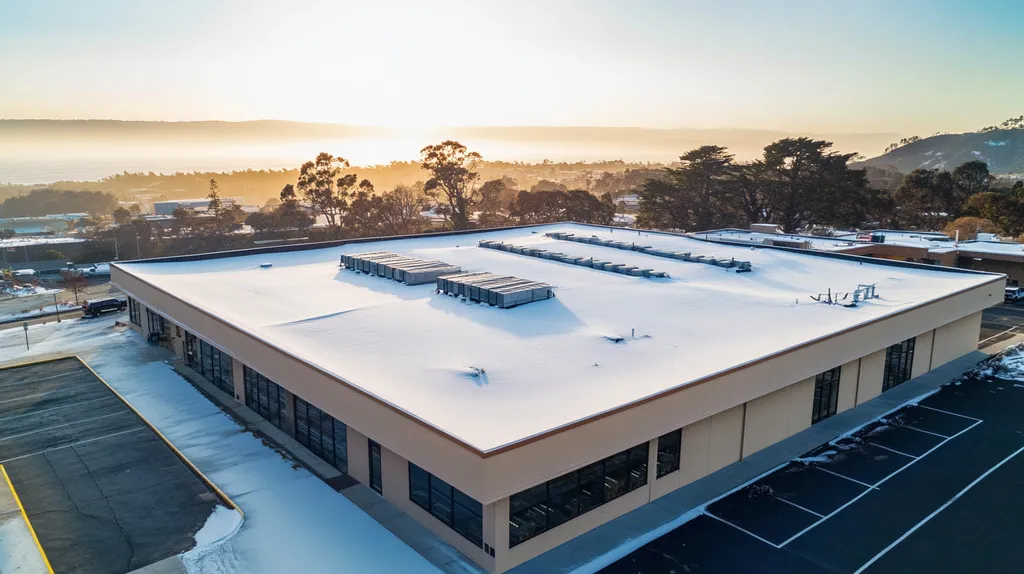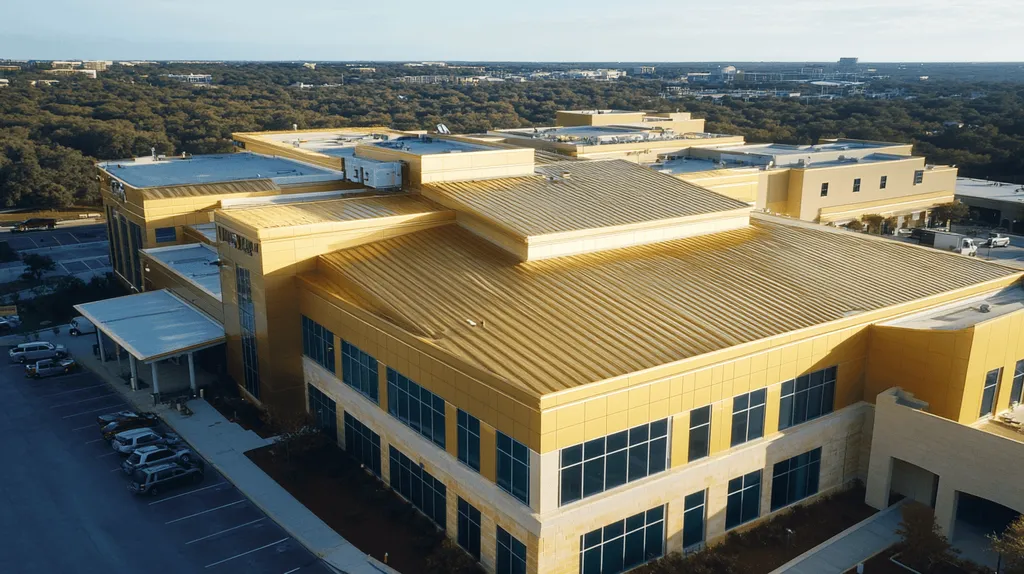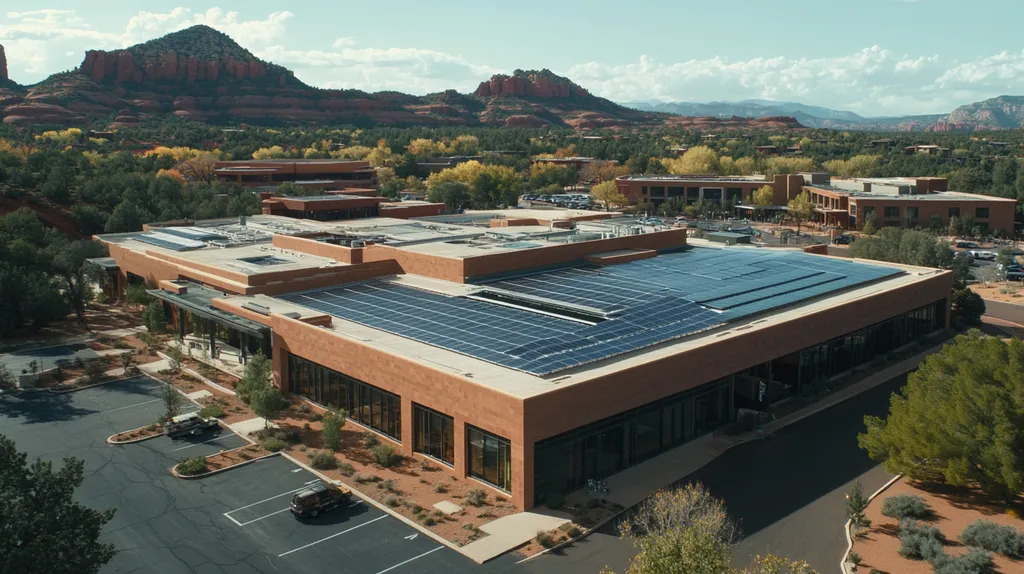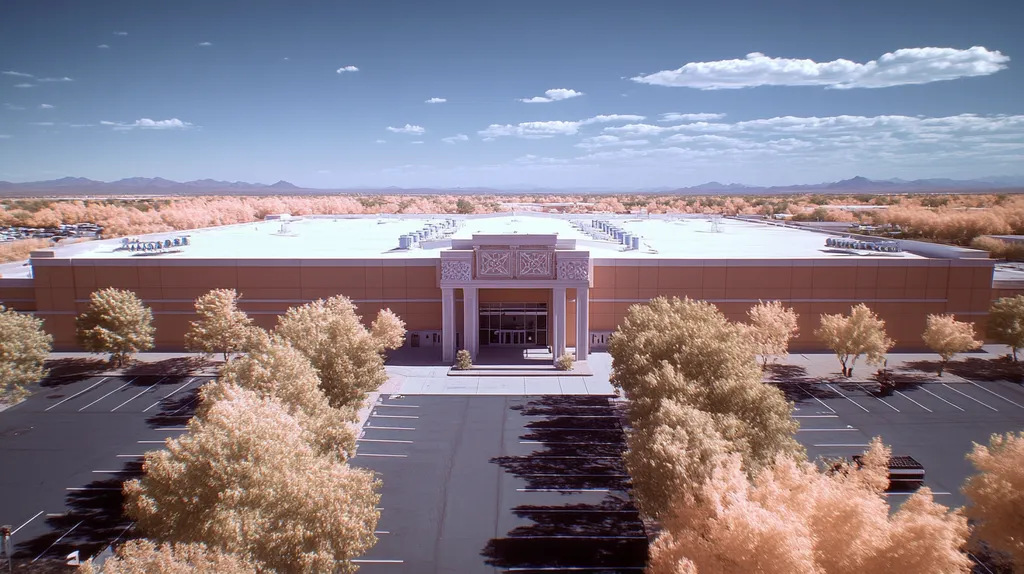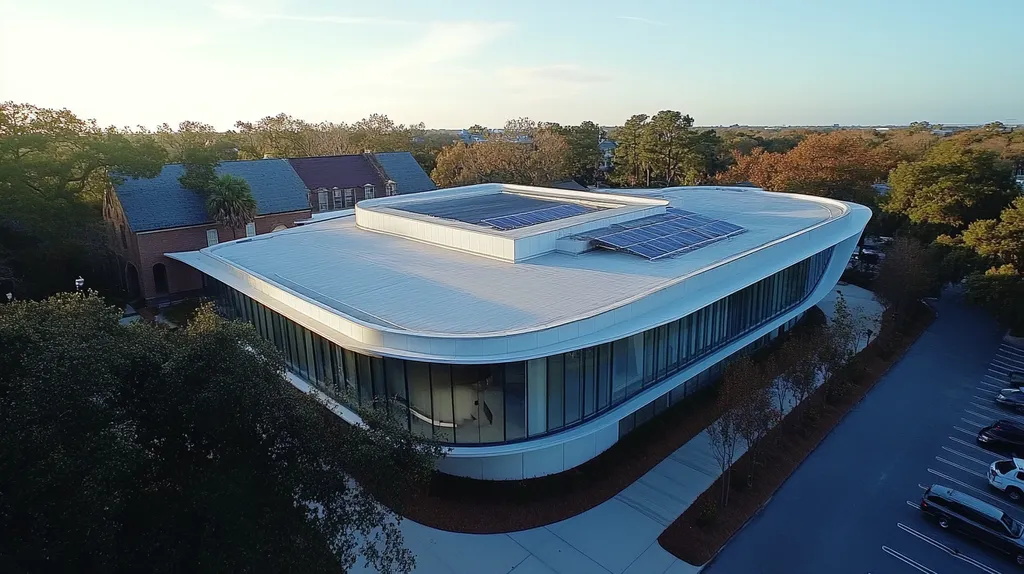Welcome to today’s Battle Royale featuring two roofing heavyweights: “Metal Roofs” in the east corner versus “Fire-Resistant Membranes” in the west!
Tonight’s showdown pits these contenders against each other across six punishing rounds designed to test every aspect of their performance for Commercial Roof Materials.
At stake? Millions in potential costs, decades of building protection, and the critical performance demands of modern commercial and industrial facilities.
Our professional judging panel will evaluate each round on technical merit, real-world performance, and value delivery. After all six rounds, we’ll declare our ultimate champion.
Ladies and gentlemen, facility managers and building owners… it’s time to rumble!
ROUND 1: INITIAL COSTS & INSTALLATION
When fire safety meets budget constraints, commercial property owners face critical decisions about roofing materials. With building codes becoming increasingly stringent and insurance costs rising, the choice between metal roofs and fire-resistant membranes can impact both safety compliance and financial planning. Understanding the initial investment landscape helps decision-makers navigate these crucial choices.
Material Expenses
Class A fire-rated materials represent the highest level of protection available for commercial roofing, making their cost consideration essential for code compliance and safety. Both metal roofs and fire-resistant membranes must meet rigorous ASTM E108 testing standards to achieve their fire ratings. (source: Intertek)
Metal roofing systems typically range from $7 to $15 per square foot for commercial applications, representing a significant upfront investment. However, their inherent fire resistance and durability often translate to lower insurance premiums and reduced long-term maintenance costs.
Fire-resistant membrane systems generally cost between $4 to $9 per square foot, offering a more budget-friendly initial investment. While these systems provide excellent fire protection, they may require more frequent replacement and maintenance over time.
When considering total cost of ownership and longevity, metal roofing systems demonstrate superior value despite higher initial costs.
ADVANTAGE: Metal Roofs
Installation Complexity
Installation complexity directly impacts project success and long-term performance. Metal roof installation requires specialized training and precise techniques to ensure proper fire protection and weatherproofing.
Metal roofing systems demand exact measurements, custom fitting, and careful attention to seams and fasteners. These requirements typically extend installation time and increase labor costs but result in superior performance when properly executed.
Fire-resistant membranes offer simpler installation processes with fewer specialized tools required. Their flexibility and larger sheet sizes allow for faster coverage and easier adaptation to roof features.
The straightforward nature of membrane installation reduces labor costs and minimizes the risk of installation errors.
ADVANTAGE: Fire-Resistant Membranes
Project Timeline
Project duration significantly impacts business operations and overall costs. Commercial properties must balance installation time against operational disruptions and weather considerations.
Metal roof installations typically require 25-40% more time than membrane installations due to precise cutting, fitting, and securing requirements. This extended timeline can increase exposure to weather risks during installation.
Fire-resistant membrane systems can often be installed in half the time of metal roofing, minimizing business disruption. Their rapid deployment helps reduce labor costs and allows for quicker project completion.
The efficiency of membrane installation provides a clear advantage for properties requiring minimal downtime.
ADVANTAGE: Fire-Resistant Membranes
ROUND 1 WINNER: Fire-Resistant Membranes
ROUND 2: DURABILITY & LIFESPAN
Every commercial roofing decision carries long-term implications for building protection and operational costs. With extreme weather events increasing and fire safety regulations tightening, the durability and lifespan of roofing materials have become critical factors in asset protection strategies. Recent industry data shows that premature roof failure can cost businesses up to 40% more than planned replacement, making material selection a high-stakes decision.
Durability Against Environmental Stressors
Environmental resistance directly impacts a roof’s ability to maintain its fire-protective qualities over time. Metal roofing systems demonstrate exceptional resistance to UV radiation, extreme temperatures, and impact damage, helping preserve their protective properties throughout their service life.
These systems can withstand winds up to 140 mph and show minimal degradation even after decades of exposure to harsh conditions. Their rigid structure resists punctures and tears that could compromise fire safety ratings.
Fire-resistant membranes offer good environmental protection but can be more vulnerable to physical damage. While they resist UV degradation effectively, they may require more frequent inspections to ensure their fire-resistant properties remain intact.
ADVANTAGE: Metal Roofs
Lifespan and Maintenance Requirements
A commercial roof’s lifespan directly affects the total cost of ownership and long-term fire safety compliance. Metal roofs typically last 40-70 years with proper maintenance, maintaining their fire-resistant properties throughout their service life.
Regular maintenance for metal roofs primarily involves inspecting seams and fasteners, with minimal material degradation over time. This longevity helps preserve the building’s fire safety rating without frequent material replacement.
Fire-resistant membranes generally last 20-30 years before requiring replacement. While they perform well initially, their fire-resistant properties may diminish over time, particularly in areas exposed to harsh weather conditions.
ADVANTAGE: Metal Roofs
Performance Under Fire Hazard Conditions
Both metal roofs and fire-resistant membranes must undergo rigorous testing to achieve their fire ratings. Metal roofs provide inherent fire resistance through their non-combustible nature and maintain this protection throughout their lifespan. (source: Intertek)
These systems excel at preventing fire spread and typically maintain their protective properties even after exposure to extreme heat or flame. Their solid construction provides a reliable barrier against both direct flame contact and airborne embers.
Fire-resistant membranes rely on specialized chemical treatments and materials to achieve their fire rating. While effective when new, their fire-resistant properties may require more frequent verification and testing to ensure ongoing protection.
ADVANTAGE: Metal Roofs
ROUND 2 WINNER: METAL ROOFS
ROUND 3: PERFORMANCE FACTORS
Fire safety performance in commercial roofing has become increasingly critical as climate change drives more extreme weather events and urban development creates denser building environments. Recent data shows that roof-related fire incidents have increased by 23% in commercial structures over the past decade, making material selection a crucial safety decision. Understanding how different roofing materials perform under fire conditions can mean the difference between containing a small incident and experiencing catastrophic loss.
Fire Rating Standards
Fire rating standards form the foundation of roofing material selection and building code compliance. ASTM E108 testing evaluates roofing materials based on flame spread, burning brand resistance, and overall fire protection capabilities. (source: Intertek)
Metal roofing systems consistently achieve and maintain Class A fire ratings due to their non-combustible nature. Their solid construction provides reliable protection against both direct flame contact and wind-blown embers, with minimal degradation over time.
Fire-resistant membranes can also achieve Class A ratings through specialized chemical treatments and material composition. However, their performance may vary based on installation quality and environmental exposure.
ADVANTAGE: Metal Roofs
Heat Resistance and Insulation
A roof’s ability to resist heat transfer directly impacts its fire protection capabilities. Metal roofs excel at reflecting solar radiation and dissipating heat, helping maintain lower surface temperatures even during extreme heat events.
The reflective properties of metal roofing systems create an effective thermal barrier that reduces the risk of heat-related degradation. This characteristic helps preserve the material’s fire-resistant properties throughout its service life.
Fire-resistant membranes provide good initial heat resistance but may become more vulnerable to thermal stress over time. Prolonged exposure to high temperatures can potentially compromise their protective properties.
ADVANTAGE: Metal Roofs
Performance Monitoring and Verification
Regular assessment of fire protection capabilities ensures ongoing safety compliance. Metal roofs require minimal specialized testing to verify their fire resistance, as their protective properties remain largely unchanged over time.
The stable nature of metal roofing systems allows for straightforward visual inspections and simple maintenance routines. This consistency helps maintain reliable fire protection throughout the roof’s lifespan.
Fire-resistant membranes typically require more frequent testing and verification to ensure their protective properties remain effective. Environmental exposure and physical damage can impact their fire resistance, necessitating regular professional evaluation.
ADVANTAGE: Metal Roofs
ROUND 3 WINNER: METAL ROOFS
ROUND 4: MAINTENANCE REQUIREMENTS
Maintenance practices directly impact a commercial roof’s fire safety performance and longevity. Industry data shows that poorly maintained roofing systems account for 47% of premature failures, compromising both safety ratings and structural integrity. For property owners balancing fire protection with operational costs, understanding the maintenance demands of different roofing systems becomes crucial for long-term risk management.
Scheduled Maintenance Requirements
Metal roofing systems typically require minimal scheduled maintenance, with annual inspections focusing on seam integrity and fastener condition. Their robust construction and inherent fire resistance remain stable throughout their service life, reducing the need for frequent interventions.
Professional inspections for metal roofs primarily involve checking for surface corrosion and ensuring drainage systems remain clear. These routine checks help maintain both structural integrity and fire safety ratings without extensive intervention.
Fire-resistant membranes demand more frequent scheduled maintenance to preserve their protective properties. Regular inspections must verify membrane integrity, seam conditions, and surface wear that could compromise fire resistance.
Membrane systems typically require biannual professional assessments and more frequent general inspections, increasing both maintenance frequency and associated costs.
ADVANTAGE: Metal Roofs
Emergency Repair Considerations
Metal roofs demonstrate exceptional resistance to damage from severe weather and impact, minimizing the need for emergency repairs. Their solid construction helps maintain fire safety ratings even after exposure to extreme conditions.
When repairs are necessary, metal roofing systems typically require localized fixes that don’t compromise the overall system integrity. These targeted repairs help maintain consistent fire protection across the roof surface.
Fire-resistant membranes show greater vulnerability to punctures, tears, and weather-related damage requiring immediate attention. Emergency repairs often involve larger sections to ensure continuous fire protection.
The higher frequency of emergency repairs for membrane systems increases both maintenance costs and potential disruption to building operations.
ADVANTAGE: Metal Roofs
Long-term Maintenance Costs
Metal roofing systems demonstrate superior cost efficiency in long-term maintenance scenarios. Their durable construction and stable fire-resistant properties reduce the need for extensive maintenance interventions over their lifespan.
Annual maintenance costs for metal roofs typically remain consistent and predictable, allowing for more accurate budget planning. The stability of their fire-resistant properties reduces the need for specialized treatments or coatings.
Fire-resistant membranes often incur escalating maintenance costs as they age. Their need for periodic recoating, seam repairs, and fire-resistance verification can significantly impact long-term maintenance budgets.
The cumulative cost difference between these systems strongly favors metal roofing’s lower maintenance requirements.
ADVANTAGE: Metal Roofs
ROUND 4 WINNER: Metal Roofs
ROUND 5: SUSTAINABILITY CREDENTIALS
Environmental responsibility has become a defining factor in commercial roofing decisions, with sustainability metrics now directly impacting property valuations and insurance rates. Recent industry data shows that buildings with sustainable roofing systems command 7-10% higher market values and qualify for enhanced insurance benefits. For facility managers balancing fire safety with environmental stewardship, understanding the sustainability profiles of roofing materials has become essential for long-term asset protection.
Recyclability
Material recyclability directly impacts a building’s environmental footprint and end-of-life disposal costs. Metal roofs lead the industry in recycled content, with most systems containing 25-95% recycled material and maintaining 100% recyclability at end-of-life.
These systems can be repeatedly recycled without degradation, reducing raw material demand and manufacturing energy consumption. Their durability ensures decades of service before recycling becomes necessary.
Fire-resistant membranes present greater recycling challenges due to their composite materials and chemical treatments. While some manufacturers offer take-back programs, most membrane materials eventually contribute to landfill waste.
ADVANTAGE: Metal Roofs
Energy Efficiency
Metal roofs demonstrate superior thermal performance through their inherent reflectivity and ability to support advanced insulation systems. Their surface properties reflect up to 70% of solar radiation, significantly reducing cooling loads and urban heat island effects.
The stable structure of metal roofing provides an excellent platform for solar installations and green roof systems, further enhancing energy performance. Their fire-resistant properties remain uncompromised when integrated with these sustainable technologies.
Fire-resistant membranes can achieve good energy efficiency when properly specified but generally offer fewer options for sustainable technology integration. Their energy performance may degrade over time as surface properties change with exposure.
ADVANTAGE: Metal Roofs
Environmental Impact
Metal roofs excel in minimizing environmental impact through their longevity and inherent fire resistance. Their non-combustible nature eliminates the need for chemical fire retardants, reducing potential environmental contamination. (source: Avalon Roofing)
These systems require minimal chemical treatments throughout their service life, reducing the release of volatile organic compounds and other pollutants. Their durability prevents frequent replacement cycles that would increase material consumption.
Fire-resistant membranes often rely on chemical treatments to achieve their protective properties, potentially impacting air and water quality. Their shorter lifespan increases the environmental burden through more frequent manufacturing and disposal cycles.
ADVANTAGE: Metal Roofs
ROUND 5 WINNER: Metal Roofs
ROUND 6: SPECIALIZED APPLICATIONS
The increasing complexity of modern commercial facilities demands specialized roofing solutions that balance fire safety with unique operational requirements. Recent data shows that facilities with customized fire-resistant roofing systems reduced fire-related incidents by 85% compared to standard installations. For specialized applications like data centers, chemical storage facilities, and healthcare environments, the choice between metal roofs and fire-resistant membranes can significantly impact both safety compliance and operational continuity.
High-Risk Environment Performance
In facilities handling flammable materials or critical operations, roofing system performance directly impacts safety protocols and insurance requirements. Fire-resistant membranes can achieve superior protection through specialized layering systems that combine multiple fire-resistant components.
When designed with polyiso insulation and gypsum-fiber roof boards, fire-resistant membrane systems consistently achieve and maintain Class A fire ratings in high-risk settings. (source: GAF)
Metal roofs, while inherently non-combustible, can present challenges in high-risk environments due to their heat conduction properties. Their performance may require additional fire-resistant underlayments to meet specialized facility requirements.
ADVANTAGE: Fire-Resistant Membranes
Regulatory Compliance
Specialized facilities often face stricter regulatory requirements and more frequent compliance inspections. Fire-resistant membranes typically offer easier documentation and verification of fire-resistant properties through standardized testing protocols.
These systems allow for straightforward modifications to meet changing regulatory requirements without complete system replacement. Their modular nature enables targeted upgrades to maintain compliance in specific areas.
Metal roofing systems, while durable, can present challenges when regulations require modifications or enhanced fire resistance. Their rigid structure makes localized improvements more complex and costly.
ADVANTAGE: Fire-Resistant Membranes
Operational Integration
Modern facilities often require roofing systems that can accommodate specialized equipment, ventilation systems, and safety features. Fire-resistant membranes offer superior flexibility in integrating with complex mechanical systems while maintaining fire protection.
These membrane systems allow for easier installation of roof penetrations and equipment mounts without compromising their fire-resistant properties. Their adaptability supports facility modifications without extensive system disruption.
Metal roofs require more complex modifications to accommodate specialized equipment. Their rigid structure can complicate the integration of new systems and may compromise fire resistance at modification points.
ADVANTAGE: Fire-Resistant Membranes
ROUND 6 WINNER: Fire-Resistant Membranes
AND THE WINNER IS…
After six grueling rounds of technical evaluation, we have our verdict…
In a dominant 4-2 performance, METAL ROOFING claims the championship belt! This powerhouse contender dominated with knockout victories in durability, performance, maintenance, and sustainability rounds, showcasing unmatched longevity and reliable fire protection that stands the test of time.
Metal roofing’s combination of inherent fire resistance, minimal maintenance requirements, and exceptional environmental credentials proved too formidable for its challenger to overcome. Its 40-70 year lifespan and superior recyclability delivered a technical knockout that couldn’t be ignored.
Yet Fire-Resistant Membranes showed impressive capability in specialized applications and initial cost considerations. For facilities requiring rapid installation or complex equipment integration, this contender remains a strong choice worthy of consideration.
Remember, fans, every building faces unique challenges. Local climate conditions, specific facility requirements, and regional building codes can all impact material selection. While tonight’s match showcased general strengths, property owners should always consult qualified roofing professionals who can evaluate their specific situation.
In the high-stakes arena of commercial roofing, victory goes not to the strongest contender alone, but to the solution that best matches your facility’s unique demands. Choose wisely, and may your roof reign supreme!
FREQUENTLY ASKED QUESTIONS
Q. How do initial costs compare for commercial roofs?
A. Metal roofs generally cost between $7 to $15 per square foot, while fire-resistant membranes range from $4 to $9. Although metal roofing has a higher initial investment, its durability often results in lower insurance premiums and maintenance costs over time.
Q. What is the lifespan of industrial roofs made of different materials?
A. Metal roofs can last 40-70 years with proper maintenance, while fire-resistant membranes typically last 20-30 years. The longer lifespan of metal roofs contributes to lower total ownership costs and enhances fire safety compliance over time.
Q. How do commercial roof options perform in fire safety?
A. Metal roofs inherently offer fire resistance because they are non-combustible, while fire-resistant membranes rely on chemical treatments. Metal roofs maintain their fire-proof qualities for decades, whereas membranes may require more frequent tests to ensure ongoing protection.
Q. What are the maintenance requirements for commercial roofs?
A. Metal roofs require minimal maintenance, primarily annual inspections for seams and fasteners. In contrast, fire-resistant membranes need more frequent inspections, typically biannual, to ensure their protective properties remain intact, leading to higher long-term maintenance costs.
Q. How do commercial roofs compare in terms of sustainability?
A. Metal roofs often contain 25-95% recycled material and are fully recyclable at end-of-life. In contrast, fire-resistant membranes face recycling challenges, often resulting in landfill waste due to their composite materials and chemical treatments.
Q. How do specialized applications affect roofing material choice?
A. Certain facilities, like data centers and chemical storage, may benefit from fire-resistant membranes due to their flexible configurations and custom fire protection capabilities. However, metal roofs offer great durability and reduced risk in less specialized environments.
Q. What are the insurance implications of roof material choices?
A. Insurance premiums may vary based on roofing materials, as roofs with higher fire resistance often receive lower rates. Metal roofs typically qualify for better premiums due to their long lifespan and non-combustible properties, potentially saving owners money.

